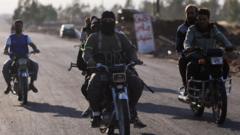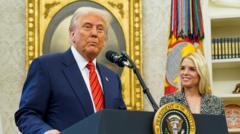As President Trump's rhetoric intensifies regarding Iran's nuclear ambitions, international observers raise concerns over potential conflict escalation and its broader implications.
# Escalating Tensions: Global Reactions to Trump's Iran Strategy

# Escalating Tensions: Global Reactions to Trump's Iran Strategy
This article explores the geopolitical ramifications of President Trump's military stance towards Iran amidst ongoing conflicts.
In a significant development on June 17, 2025, President Trump proclaimed, “we now have complete and total control of the skies over Iran,” urging for Iran’s “unconditional surrender” as tensions between the U.S. and Iran mount. This declaration coincides with mounting evidence suggesting that the United States may soon join Israel's aerial assaults on Iranian territories.
Ahead of a key national security meeting, Trump’s bold claims were shared on his social media platform. While he maintained control over Iran’s airspace, only Israel has operated combat missions with U.S.-made aircraft, reportedly dismantling much of Iran's air defense network.
The Pentagon is already strategizing for potential further involvement, dispatching around three dozen refueling aircraft to Europe. These aircraft would support American military operations in the Middle East and have the capability to refuel B-2 bombers en route to strike sites, particularly the Fordo nuclear enrichment facility in Iran, which was designed to withstand extensive bombardment.
Trump's assertive military posture marks a stark departure from his previously optimistic discussions about achieving a nuclear agreement with Iran. Just days prior, he had expressed confidence in brokering a deal, but the unfolding events in the Middle East prompted him to cut short his participation at the Group of Seven summit in Canada.
The choice to deploy America’s most powerful conventional weapon—the 30,000-pound Massive Ordnance Penetrator—against Iran’s fortified enrichment site has become a focal point of deliberation, representing a critical juncture in U.S.-Iran relations.
The situation remains precarious as international leaders and analysts closely monitor developments, fearing that increased military actions could spiral into wider regional conflict, further complicating an already tense geopolitical landscape.





















